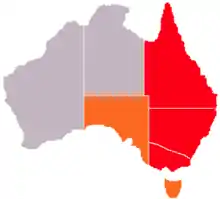Eastern states of Australia
The eastern states of Australia are the states adjoining the east coast of Australia. These are the mainland states of Victoria, New South Wales and Queensland, and the island state of Tasmania; the Australian Capital Territory and Jervis Bay Territory, while not states, are also included. On some occasions, the state of South Australia is included in this grouping.

Regardless of which definition is used, the eastern states include the majority – around 80% – of the Australian population, the federal capital, Canberra, and the three largest cities: Sydney, Melbourne, and Brisbane. It also includes: the Gold Coast, Queensland; Newcastle, New South Wales; and Wollongong, New South Wales as the three largest non-capital cities in the country. In terms of climate, the area is dominated by a humid subtropical zone, with some tropical (Queensland) and oceanic climate (Australian Capital Territory, Victoria, New South Wales) zones. In most situations, the eastern states are defined as those who use Australian Eastern Standard Time (AEST), and that is the definition that this article will adhere to, unless noted.
Divisions between the east and west
Since the 1980s, governments have proposed building a high-speed rail in Australia. However, this rail would only go through the eastern states of Victoria, New South Wales and Queensland.[1][2] Adelaide has often been included in the proposal, however former Greens leader Bob Brown said that a rail connecting Perth was inevitable.[3]
Politicians and newspapers from Western Australia frequently use the term(s) to emphasise the "them and us" attitude with respect to the state's isolation from the rest of the country. For example, in 2016 WAtoday ran an article with the headline "Ten reasons why Perth trumps the East Coast of Australia".[4]
In 2015 international visitors in Australia spent $24.1 billion. The eastern states and territory made $20.5 billion of that total, or 85%.[5][6] Likewise, the eastern states collected 8,588,000 (85%) individual visits to a state over that year, out of a possible 10,133,000.[5]
Population
The combined population of Queensland, New South Wales, Australian Capital Territory, Victoria and Tasmania is 19,484,100, or 81% of Australia's population.[7] These five states and territory cover 2,829,463 km², or 37% of Australia's total land area.[8]
Cities
Greater Capital City Statistical Area (GCCSA) or Significant Urban Areas (SUA), with a population of over 30,000, from north to south:
| City[9] | State/territory | Population | Percentage of national population |
|---|---|---|---|
| Cairns | Queensland | 178,649 | 0.80% |
| Townsville | Queensland | 162,292[10] | 0.73% |
| Mackay | Queensland | 85,040 | 0.36% |
| Rockhampton | Queensland | 80,345 | 0.38% |
| Gladstone | Queensland | 32,073 | 0.14% |
| Bundaberg | Queensland | 70,540 | 0.32% |
| Hervey Bay | Queensland | 48,680 | 0.22% |
| Sunshine Coast | Queensland | 297,380 | 1.33% |
| Brisbane | Queensland | 2,274,560 | 10.18% |
| Toowoomba | Queensland | 113,625 | 0.51% |
| Gold Coast-Tweed Heads | Queensland/New South Wales | 614,379 | 2.75% |
| Coffs Harbour | New South Wales | 68,052 | 0.29% |
| Tamworth | New South Wales | 41,810 | 0.18% |
| Port Macquarie | New South Wales | 44,875 | 0.19% |
| Dubbo | New South Wales | 36,622 | 0.16% |
| Newcastle-Maitland | New South Wales | 430,755 | 1.83% |
| Orange | New South Wales | 39,766 | 0.17% |
| Central Coast (Gosford) | New South Wales | 304,753 | 1.36% |
| Bathurst | New South Wales | 35,391 | 0.15% |
| Sydney | New South Wales | 4,840,628 | 20.61% |
| Wollongong | New South Wales | 289,236 | 1.23% |
| Bowral-Mittagong | New South Wales | 37,495 | 0.16% |
| Nowra-Bomaderry | New South Wales | 35,383 | 0.15% |
| Mildura-Wentworth | Victora/New South Wales | 49,836 | 0.21% |
| Wagga Wagga | New South Wales | 55,364 | 0.24% |
| Canberra-Queanbeyan | Australian Capital Territory/New South Wales | 422,510 | 1.80% |
| Albury-Wodonga | New South Wales/Victoria | 87,890 | 0.37% |
| Shepparton-Mooroopna | Victoria | 49,079 | 0.21% |
| Bendigo | Victoria | 91,692 | 0.39% |
| Ballarat | Victoria | 98,543 | 0.42% |
| Melbourne | Victoria | 4,440,328 | 18.90% |
| Warragul-Drouin | Victoria | 32,698 | 0.14% |
| Geelong | Victoria | 184,182 | 0.78% |
| Traralgon-Morwell | Victoria | 40,851 | 0.17% |
| Warrnambool | Victoria | 33,856 | 0.14% |
| Devonport | Tasmania | 30,445 | 0.13% |
| Launceston | Tasmania | 86,393 | 0.37% |
| Hobart | Tasmania | 219,243 | 0.93% |
| Total: | 16,085,239 | 68.58% | |
References
- "Turnbull plan to put Australia back on the slow road towards high-speed rail". The Age.
- "Greens to push $40bn fast-rail link to Sydney". The Age. Archived from the original on 4 November 2012.
- "Study on the impact of a high-speed rail line on Sydney Airport". The Sydney Morning Herald. Archived from the original on 7 November 2012.
- Rebecca Boteler (29 March 2016). "Ten reasons why Perth trumps the East Coast". WA Today.
- "Archived copy" (PDF). Archived from the original (PDF) on 8 May 2016. Retrieved 21 April 2016.CS1 maint: archived copy as title (link)
- "International Visitors In Australia: Year Ending December 2015" (PDF). Tourism Research Australia. Archived from the original (PDF) on 11 March 2016.
- "Australian Demographic Statistics, Mar 2016". abs.gov.au. Australian Bureau of Statistics. 22 March 2016. Retrieved 23 September 2016.
- "Area of Australia – States and Territories". ga.gov.au. Geoscience Australia. Retrieved 23 September 2016.
- "Census of Population and Housing".
- "2011 Census QuickStats: Townsville".
Further reading
| Wikivoyage has a travel guide for Eastern Australia. |
- Doenges, Debra and Andrew Teakle.(2008) Australian journey : east coast Sydney : New Holland Publishers Australia. ISBN 978-1-74110-628-2